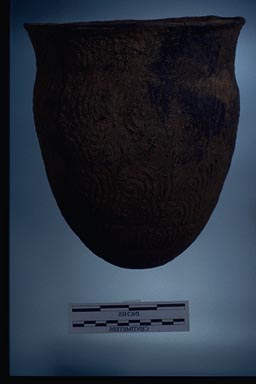Home Page
A VISUAL TOUR OF GEORGIA'S PREHISTORIC PAST:
INDIAN TECHNOLOGY FROM 9,500 B.C. to A.D. 1540
Page 3

This ceramic vessel was discovered at the Hickory Log Site in Cherokee County, Georgia. It was made sometime around A.D. 1300. Note that this pot is not painted. Prehistoric Indian pottery from Georgia, and most areas of the Southeast, was either plain or had designs carved or stamped into the surface when the clay was still malleable. Also note that the base is rounded. This type of vessel was made to be placed in a depression on the ground, or in a prepared pit. It was probably used for storing dry goods as well as liquids.

This ceramic vessel was produced about A. D. 700 ; it was discovered at a rockshelter in Rockdale County, Georgia. The intricate geometric designs were created with a carved wooden paddle that imprinted the surface before the clay had hardened.

This is an example of a plain pot that was also made about A.D. 700. It was found in a pit at the Chase Site (Georgia International Horse Park) in Rockdale County, Georgia. Charcoal in the pit was radiocarbon dated, and the results indicate that there is a 99.6 percent probability that it was in use between A.D. 680 and A.D. 710.
To Page 2 of the Visual Tour